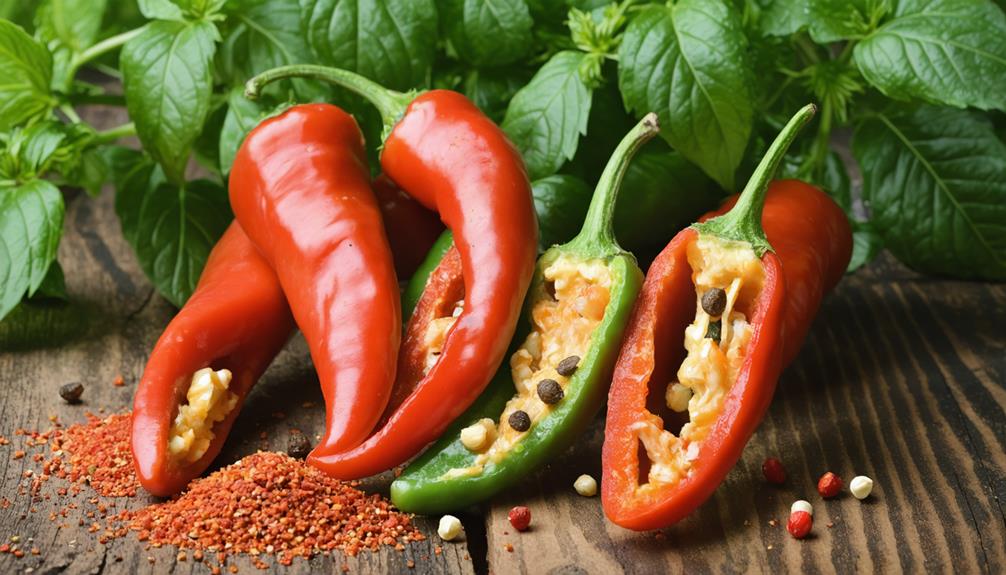
Brainstorm Security Shop

For Orders Over $199

On Any Of Our Products

Details On Refund Page
When you think about the heat in your favorite chili dish, major capsaicinoids like capsaicin and dihydrocapsaicin come to mind as key players. These compounds don’t just add spice; they interact with your body in fascinating ways, activating specific receptors that create that familiar burning sensation. Beyond just flavor, they hold potential health benefits and culinary applications that are worth exploring. But what exactly makes these compounds so unique, and how might they continue to influence both our kitchens and our well-being?
Capsaicinoids are naturally occurring compounds found in chili peppers that give them their characteristic heat. You might’ve experienced their intensity when biting into a spicy dish.
The chemical composition of capsaicinoids primarily includes capsaicin, dihydrocapsaicin, and several other related compounds, each contributing to the overall spiciness you taste.
When you eat chili peppers, the sensory effects of capsaicinoids kick in almost immediately. They activate the TRPV1 receptors in your mouth, which are responsible for sensing heat and pain. This interaction sends signals to your brain, making you feel a burning sensation. It’s fascinating how these compounds can trick your body into perceiving heat even though there’s no actual temperature increase.
You might also notice that the level of heat can vary significantly between different types of chili peppers, depending on their concentration of capsaicinoids. So, whether you’re a spice lover or prefer milder flavors, understanding capsaicinoids can enhance your culinary experiences. Embracing the heat can lead to a deeper appreciation for the complexity of flavors in your favorite spicy dishes.
There are several major types of capsaicinoids, each playing a unique role in the spiciness of chili peppers. The most well-known is capsaicin, which is responsible for the heat you feel when consuming spicy foods.
Then there’s dihydrocapsaicin, which is nearly as potent as capsaicin and contributes to the overall heat sensation. Other types include nordihydrocapsaicin and homodihydrocapsaicin, which have milder heat levels but still add complexity to the flavor profile.
Understanding capsaicinoid synthesis is crucial for those interested in cultivating spicier peppers. The synthesis process occurs primarily in the placental tissue of the pepper, where various enzymes and substrates work together to produce these compounds.
When it comes to capsaicinoid extraction, methods like solvent extraction or supercritical fluid extraction are commonly used to isolate these compounds from the pepper. This extraction allows for the creation of concentrated spice products, enhancing the culinary experience.
The spicy compounds found in chili peppers, known as capsaicinoids, offer a range of health benefits that go beyond just adding heat to your meals. One of the most notable benefits is pain relief. Capsaicin has been shown to reduce the sensation of pain by depleting substance P, a neurotransmitter that sends pain signals to your brain. So, if you’re dealing with chronic pain or arthritis, incorporating capsaicinoids into your diet might just provide some comfort.
Additionally, capsaicinoids can aid in weight loss. They boost your metabolism and increase energy expenditure, helping your body burn more calories. By adding spicy foods to your meals, you might find it easier to manage your weight while enjoying flavorful dishes. Plus, the heat from capsaicinoids can curb your appetite, making it less likely that you’ll overeat.
Incorporating capsaicinoids into your routine could lead to significant health improvements. From providing relief from discomfort to supporting your weight management goals, these spicy compounds are more than just a culinary delight; they’re a powerful addition to your wellness journey.
When you want to add a kick to your dishes, capsaicinoids are your go-to ingredient. These compounds, found in chili peppers, pack a punch that can elevate your meals, making them more exciting and flavorful. Incorporating capsaicinoids into your cooking opens up a world of culinary creativity. You can experiment with different types of peppers to find the perfect heat level that suits your palate.
Capsaicinoids not only add spiciness but also enhance the overall flavor profile of your dishes. Whether you’re preparing a spicy salsa, a zesty curry, or a fiery stir-fry, a dash of capsaicinoids can transform a mundane recipe into a memorable feast. You’ll notice that the heat complements other flavors, creating a well-rounded dish.
Don’t shy away from using capsaicinoids in marinades, sauces, or even desserts. A hint of chili in chocolate, for example, offers a bold contrast that many enjoy. Just remember to adjust the amount you use based on your guests’ preferences.
With capsaicinoids, you can truly unleash your inner chef and impress everyone at the table!
As research into capsaicinoids continues to evolve, exciting possibilities for their applications in various fields are emerging. You’ll find that one of the most promising areas is medical applications. Capsaicinoids have shown potential in pain management, particularly for conditions like arthritis and neuropathy. Their ability to modulate pain receptors makes them a candidate for developing new analgesic treatments.
Moreover, sustainability research is gaining traction with capsaicinoids as well. As the world searches for eco-friendly solutions, the cultivation of capsaicin-rich peppers presents a sustainable agricultural opportunity. These plants often require less water and can thrive in poorer soil conditions, making them an appealing choice for farmers looking to maintain biodiversity while producing valuable compounds.
In the realm of food science, researchers are investigating how capsaicinoids can be used as natural preservatives, extending shelf life without the need for artificial additives. As you explore these avenues, you’ll discover that the future of capsaicinoids holds immense promise.
Whether in healthcare or sustainable practices, the ongoing research into these compounds is set to revolutionize various industries while addressing pressing contemporary issues.
Capsaicinoids aren’t safe for pets. Their consumption can lead to pet toxicity, causing discomfort and potential health issues. Always keep spicy foods away from your furry friends to ensure their well-being and safety.
Yes, capsaicinoids can cause allergic reactions in some individuals. Symptoms may include itching or swelling. If you suspect capsaicinoid sensitivity, take precautions by avoiding spicy foods and consulting a healthcare professional for guidance.
You can extract capsaicinoids from chili peppers using various extraction methods like solvent extraction or steam distillation. After extraction, you’ll want to conduct purity testing to ensure the quality and concentration of the compounds.
Capsaicinoids can interact with some medications, affecting their absorption or metabolism. You should consult your healthcare provider to ensure medication safety and avoid potential drug interactions that might impact your treatment effectiveness or cause side effects.
Yes, capsaicinoids can be used in skincare products. They offer skincare benefits like increased circulation and potential anti-inflammatory properties, making them valuable in cosmetic formulations aimed at improving skin appearance and health.

Brainstorm Security Shop
1867 Caravan Trail
Ste 105
Jacksonville, FL 32216
Call us toll free: (800) 859-5566